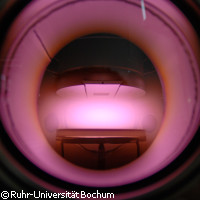New insight into energy coupling in plasmas
Researchers from Ruhr University Bochum in Germany and the University of California, Berkeley in the US have discovered a mechanism for energy coupling in low-temperature plasmas that radically improves our understanding of how these versatile, manmade plasmas actually work. Plasma is an ionised gas, or a collection of free-moving electrons and ions, that is electrically neutral and constitutes a state of matter separate from gases, liquids and solids. It is electrically conductive and can be steered by electromagnetic fields, which makes it ideal for application in any number of innovative technologies. Low-temperature (or 'technological') plasmas make possible countless feats of micro-processing, lighting and engineering. Their versatility is largely attributed to their 'thermal non-equilibrium', whereby the difference in temperature between their very hot electrons (with temperatures exceeding 10,000°C) and comparatively cool ions and neutral atoms can be used to initiate reactions such as those used to form the structure on microchips. The specific energy coupling mechanism (how the energy produced in one reaction is transferred to another) that makes this thermal non-equilibrium possible has until now been a matter of vigorous debate. The process that allows the electrons to heat up so dramatically, particularly at very low gas pressures, has been understood in general terms but there has been a significant gap between what is understood theoretically and what can be demonstrated in practice. Dr Thomas Mussenbrock and colleagues, in a study published in Physical Review Letters, defined the heating mechanism of electrons in low-temperature plasmas both theoretically and experimentally. They demonstrated how, specifically, these plasmas oscillate, and how this property controls the electron heating process. Plasmas are not uniform, and their properties vary somewhat at the edges. The tendency of plasma to oscillate is not precisely uniform, as it can have slightly different effects at the so-called 'boundary sheath'. An excitation of the oscillation occurring at the boundary sheath can in turn lead to a 'self-excitation' of the oscillation in the plasma's electrical current. The process, called 'non-linear electron resonance heating', can more than double the efficiency of energy coupling. The new understanding of non-linear electron resonance heating provided by Dr Mussenbrock and colleagues provides new insight into the properties of low-temperature plasma. Their findings have wide-reaching implications for research in the fields of energy, engineering, manufacturing, lighting, surface cleaning and waste removal, to name but a few.
Countries
Germany, United States



